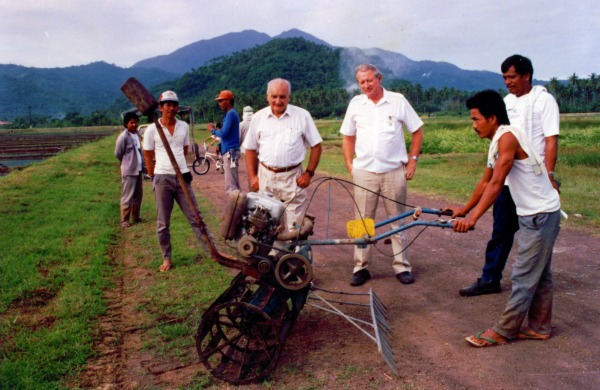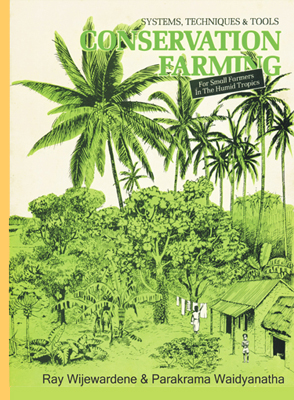Sustainable agriculture

Having been at the forefront of the ‘Green Revolution’ during its early years, Ray Wijewardene soon stepped back to question its assumptions and approaches. He later acknowledged that farming with high external inputs was not sustainable either economically or ecologically.
 We need to optimize –- not maximize -- the available land area for producing food and other crops for a rapidly increasing population. We need to optimize –- not maximize -- the available land area for producing food and other crops for a rapidly increasing population. - Ray Wijewardene |
As he said in 1995: “There is now an increasing realisation both among the farmers, and more slowly among the scientists and agricultural policy makers, that a return to some traditional systems practised in the past is the best option. Those systems had low external inputs, and optimum recycling of locally available inputs.”
But he did not romanticise traditional systems. Instead, he was keen to adapt them to meet the complex challenges of the modern world.
Through years of experimentation in Asia and Africa (and after much trial-and-error), he reached conceptual clarity on some fundamental aspects in farming.
| For example (excerpts taken from Ray’s own writing/speeches): | |
| • | The Sun’s energy flows through every part of Nature, and is at the centre of all agricultural systems. “It is only comparatively recently – within the past few centuries -- that a greater appreciation has been realised of more fundamental differences between tropical agriculture (with year-round sunshine) and temperate agriculture (carried out under seasonal or ‘summer’ sunshine which may last only for a few months in the year)." |
| • | Tropical and temperature agriculture are very different in land use. “We have to question whether we practise correct type of agriculture. Many forms of ‘bare-soil’ agriculture, as practised in countries with a temperate vegetation and climate, have been blindly adopted in the tropics…Sri Lanka’s agricultural authorities have been ‘brainwashed’ totally by the ‘open field’ concepts of temperate farming.” |
| • | Tropical farming is all about managing weeds and maintaining soil fertility. “Ultimately, we come to realize that farming is all about managing weeds and managing fertility. These are the two key limiting factors. In the tropical forests, both these factors are beautifully managed by Nature itself. Trees are the essential link in this process -- one that can determine whether a given land will be productive or marginal.” |
| • |
To achieve sustainable agriculture, we must emulate Nature as much as possible. “In the tropics, we’ve been blessed with a perennial agricultural system: alternating cycles of rain and drought under a perennial canopy of sunshine. Our most sustainable agriculture - and nearest to the natural forest – is of palm-trees and of rubber. The natural forest has always been our most sustainable and continuing agriculture. Until, of course, man interfered!” |
|
In the early 1980s, Ray co-authored a well illustrated book titled Conservation Farming for Small Farmers in the Humid Tropics. Co-authored with Dr Parakdrama Waidyanatha, this was a pioneering effort to capture practical insights that Ray had derived from working with farmers across Asia, Africa and Latin America from the 1960s. It was published in co-operation with the Department of Agriculture, Sri Lanka and the Commonwealth Consultative Group for Agriculture for the Asia Pacific region. Technical drawings and other inputs have come from a number of colleagues working at the time with the International Institute of Tropical Agriculture (IITA), Ibadan, Nigeria, and the International Rice Research Institute (IRRI) in Los Banos, The Philippines. Financial assistance for the book was provided by the German Agency for Technical Co-operation (GTZ) and the Commonwealth Fund for Technical Co-operation (CFTC). “This was written at a time when the term conservation was hardly heard,” says Dr Ranjith Mahindapala, a Sri Lankan agricultural scientist who now works with IUCN, the International Union for Conservation of Nature. “He advocated conserving soil moisture, particularly in the dryer areas of the country by avoiding such practices as tilling and clean weeding.”
|
For further discussions, see:
![]() Reaching for the Sun: A refreshing dimension in agriculture
Reaching for the Sun: A refreshing dimension in agriculture
By Ray Wijewardene
Based on a paper that was first presented at a Pugwash Regional Workshop on Learning from Ancient Hydraulic Civilizations to Combat Climate change, hosted by Sri Lanka Pugwash Group in November 2007 in Colombo
Who Speaks for Small Farmers, Earthworms and Cow Dung?
Ray Wijewardene in conversation with Nalaka Gunawardene (interview recorded in 1995; full text published on Groundviews.org, in August 2010


